

The Leon County paleontological sites are assemblages of Early Miocene invertebrates and vertebrates of Leon County, Florida, United States.


The Leon County paleontological sites are assemblages of Early Miocene invertebrates and vertebrates of Leon County, Florida, United States.
Era : Neogene.
Period : Early Miocene.
Faunal stage : Arikareean, ~23.1–21.9 Ma, calculates to a period of approximately 1.2 million years.
Geological Formation : Torreya Formation.
Leon County paleontological sites are represented by the following:
Coordinates: 30°33′56″N84°12′58″W / 30.5655°N 84.2162°W
Coordinates: 30°18′N84°12′W / 30.3°N 84.2°W
Coordinates: 30°18′N84°12′W / 30.3°N 84.2°W
Coordinates: 30°24′N84°18′W / 30.4°N 84.3°W
Griscom Plantation Site = GPS. Seaboard Air Line Railroad = SALR. St. Marks River site = SMRS. Tallahassee Waterworks Site = TWWS.
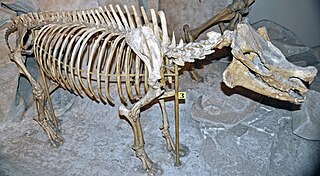
Menoceras is a genus of extinct, small rhinocerotids endemic to most of southern North America and ranged as far south as Panama during the early Miocene epoch. It lived from around 30.7—19.7 Ma, existing for approximately 11 million years.
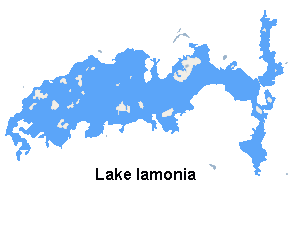
Lake Iamonia⟨aɪ ˈmoʊ njə⟩ is a large, subtropical prairie lake in northern Leon County, Florida, United States, created during the Pleistocene epoch.

Phlaocyon is an extinct genus of the Borophaginae subfamily of canids native to North America. It lives from the Early Oligocene to the Early Miocene epoch 33.3–16.3 Mya, existing for approximately 17.3 million years. It is closely related to Cynarctoides.

Hesperocyon is an extinct genus of canids that was endemic to North America, ranging from southern Canada to Colorado. It appeared during the Uintan age, –Bridgerian age (NALMA) of the Mid-Eocene– 42.5 Ma to 31.0 Ma. (AEO). Hesperocyon existed for approximately 11.5 million years.
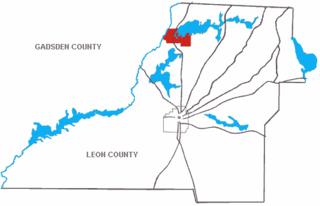
Luna Plantation was a quail hunting plantation located in northeastern Leon County, Florida, United States established by Lloyd C. Griscom.
Parahippus leonensis is an extinct proto-horse of the family Equidae that was endemic to North America during the Miocene from 23.030 to 16.3 Ma living for approximately 6.73 million years.

Nannippus is an extinct genus of three-toed horse endemic to North America during the Miocene through Pleistocene, about 13.3—1.8 million years ago (Mya), living around 11.5 million years. This ancient species of three-toed horse grew up to 3.5 feet and weighed between 165 pounds to 199 pounds, which was around the same size as a domestic sheep.
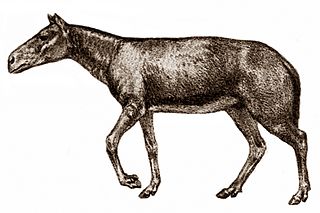
Archaeohippus is an extinct three toed member of the family Equidae known from fossils of early Oligocene to middle Miocene age. The genus is noted for several distinct skeletal features. The skull possesses deeply pocketed fossa in a notably long preorbital region. The genus is considered an example of phyletic dwarfism with adults estimated at being on average 20kg in weight. This is in contrast to the most common equid of the period, Miohippus. Characters of the teeth show a mix of both primitive and advanced traits. The advanced traits are very similar to those shown in the genus Parahippus. The noted similarities of Archaeohippus and Parahippus show them to be descended from a common ancestor and are considered sister species.

The Thomas Farm site is an Early Miocene, Hemingfordian assemblage of vertebrate fossils located in Gilchrist County, northern Florida.

The Torreya Formation is a Miocene geologic formation with an outcrop in North Florida. It is within the Hawthorn Group.

The Gadsden County paleontological sites are assemblages of Early Miocene invertebrates and vertebrates occurring in Gadsden County, Florida, United States.

The Jefferson County, Florida paleontological sites are assemblages of Mid-Miocene to Late Pleistocene vertebrates from Jefferson County, Florida, United States.
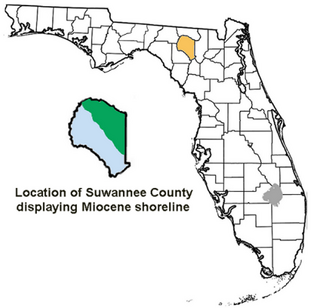
The Suwannee County, Florida paleontological sites are assemblages of Early Miocene invertebrates and vertebrates occurring in Suwannee County, Florida.
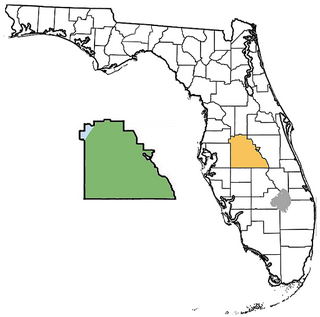
The Polk County paleontological sites are assemblages of Early Miocene to Late Pleistocene vertebrates occurring in Polk County, Florida, United States.

Stanley John Olsen was an American vertebrate paleontologist and one of the founding figures of zooarchaeology in the United States. Olsen was also recognized as an historical archaeologist and scholar of United States military insignia, especially buttons of the American Colonial through Civil War periods. He was the father of John W. Olsen.

Enhydritherium terraenovae is an extinct marine otter endemic to North America that lived during the Miocene through Pliocene epochs from ~9.1–4.9 Ma. (AEO), existing for approximately 4.2 million years.

Paleontology in Florida refers to paleontological research occurring within or conducted by people from the U.S. state of Florida. Florida has a very rich fossil record spanning from the Eocene to recent times. Florida fossils are often very well preserved.

The Mint Canyon Formation (Tm) is a Miocene geologic formation in the Sierra Pelona Mountains of Los Angeles County, southern California. The formation preserves fossils dating back to the Middle to Late Miocene.
The Tick Canyon Formation (Tt) or Tick Canyon strata, is an Early Miocene geologic formation in the Sierra Pelona Ridge of the San Gabriel Mountains in Los Angeles County, California.
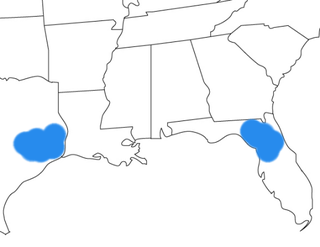
Floridachoerus olseni is an extinct peccary that lived during the Hemingfordian age of the Early Miocene, and was endemic to North America. F. olseni was in existence for approximately 4.46 million years. Remains of this extinct mammal were located at the fossil rich Thomas Farm site in Gilchrist County, Florida and Toledo Bend site, Newton County, Texas. Floridachoerus olseni was named after Stanley. J. Olsen of the Florida Geological Survey in 1962. Olsen previously worked at the site for Harvard University.